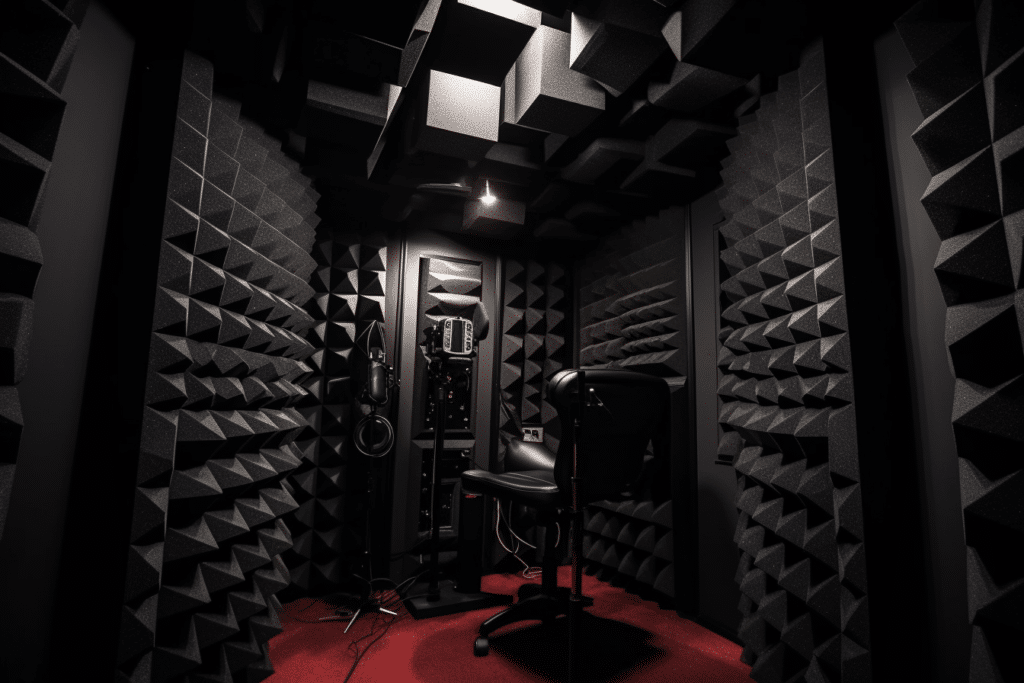.jpg)
Table of Contents
Introduction to Soundproofing Techniques
To achieve effective soundproofing, delve into the world of soundproofing techniques. Discover the importance of soundproofing in various environments as we explore the sub-sections of this segment: the benefits of soundproofing in residential areas, commercial spaces, and recreational establishments.
The Importance of Soundproofing in Various Environments
Soundproofing is an essential feature in many environments today. It enhances privacy, productivity, and wellbeing.
For example, in residential areas it reduces noise from neighbors, street traffic, and sirens to create a peaceful living space. In the office, soundproofing minimizes distractions and improves focus, leading to more employee efficiency.
In educational settings, it provides an optimal learning environment by reducing external noise and helping students concentrate. It also ensures guests have a relaxing experience in hospitality spaces. And in healthcare, it creates a calm atmosphere vital for patient recovery and confidentiality.
Other benefits of soundproofing include improved energy efficiency, fire safety, and architectural aesthetics. Techniques used include acoustic insulation materials like fiberglass or mineral wool, and double-glazed windows that provide noise reduction and thermal insulation.
Mrs. Johnson, a resident of a noisy urban neighborhood, experienced the importance of soundproofing first-hand. She found that soundproofing her apartment walls drastically improved her quality of life, allowing her to enjoy peace and quiet at home.
Having an understanding of the significance of soundproofing across different environments allows us to create spaces that promote tranquility, productivity, and comfort. Thus, soundproofing is no longer a luxury, but a necessity in today’s fast-paced and noisy world.
Soundproofing for Interior Spaces
To achieve soundproofing for interior spaces with the focus on minimizing noise transmission, explore the use of acoustic insulation materials, soundproofing walls and ceilings, and sealing doors and windows. Each of these sub-sections offers an effective solution to create a quieter environment in your living or working space.
Acoustic Insulation Materials
Soundproofing interior spaces is key to creating a peaceful environment. Acoustic insulation materials are essential to reduce sound transmission. Fiberglass, mineral wool, and cellulose insulation are popular materials with good sound absorption ratings.
For special soundproofing needs, foam panels made from polyurethane or melamine foam are often used in recording studios and home theaters.
The concept of acoustic insulation has been around for centuries. Ancient Egyptians used cloth and papyrus to create quieter living spaces. Technology advancements have led to better soundproofing materials.
Soundproofing Walls and Ceilings
Ready to make your walls and ceilings soundproof? Here are some simple strategies:
- Seal any gaps in the walls. This will stop sound from travelling through.
- Add sound-absorbing materials like acoustic panels or foam boards.
- Install thick curtains, double-glazed windows, or window inserts to block noise from outside.
- Apply mass-loaded vinyl on walls and ceilings to block airborne sounds.
;
- Use resilient channels to decouple drywall from the structure, preventing vibrations.
- Try soundproof wallpaper for a stylish option.
Also, identify and address the primary noise sources within your home. Insulate ductwork, install acoustic baffles around noisy machinery, and you’ll have a much quieter interior.
Start soundproofing now! Get rid of distractions and enjoy peaceful moments in your own personal haven. Put earplugs on your home and experience a newfound sense of serenity.
Sealing Doors and Windows
For effective soundproofing, address points of sound leakage, e.g. doors and windows. Seal these areas to reduce noise transmission and create a quieter environment. Weatherstrip edges of doors/windows to act as a barrier against sound waves. Draught excluders at the bottom of doors help minimize sound. Apply acoustic caulk along the seams/frames for absorption. Hang noise-reducing curtains over windows/glass-paneled doors. Consider double-glazed windows for extra soundproofing. Repair any gaps/cracks for best results. Combining multiple techniques creates a comprehensive approach that blocks external noise. Maintain effectiveness with regular maintenance.
Soundproofing for Exterior Spaces
To achieve soundproofing for exterior spaces with noise barriers and acoustic fencing, soundproofing for outdoor HVAC systems, and techniques for soundproofing balconies and patios is the solution. These sub-sections will delve into various methods that can effectively minimize noise pollution and enhance tranquility in outdoor areas.
Noise Barriers and Acoustic Fencing
Let’s explore the features and benefits of Noise Barriers and Acoustic Fencing. They can reduce noise pollution by absorbing, reflecting, and diffusing sound waves. Plus, they are durable due to being constructed with materials like concrete, steel, or wood. Also, they can be customized to size, shape, color, and design pattern. And, certain types use recycled materials or green walls for vegetation growth. Moreover, modern technology has created innovative designs that combine functionality and style. From art installations to patterns on the material, the options are diverse.
An example of Noise Barriers and Acoustic Fencing’s significance is a neighborhood with traffic noise. The residents couldn’t find peace in their homes until these structures were installed. Then, the area became a tranquil haven. It shows how these structures can improve the quality of life and add visual appeal. Plus, they can provide soundproofing solutions for HVAC systems without drawing attention.
Soundproofing for Outdoor HVAC Systems
Outdoor HVAC units can be loud and disruptive, both to nearby buildings and the environment. To reduce sound, soundproofing methods can be employed. These include:
- Acoustic panels
- Fences
- Vibration isolation mounts
- Duct silencers
- Equipment enclosures
- Sound-absorbing materials
Additionally, low-noise fans and compressors, as well as regular maintenance, are also recommended.
One example: a residential area near a commercial building with multiple rooftop HVAC units. The constant humming and rumbling was disturbing the peace. To fix it, soundproof barriers were put up around each system. This brought tranquility back.
So, don’t let noisy neighbors ruin your outdoor time – soundproof your balcony or patio and give their sound a taste of its own medicine!
Techniques for Soundproofing Balconies and Patios
Are you fed up with noise pollution on your balcony or patio? There are some techniques you can use to soundproof these exterior areas and create a peaceful environment for yourself and your family.
- Weatherstripping: Fill any cracks or gaps in the windows, doors and walls with weatherstripping material to block sound transmission.
- Soundproof curtains: Hang curtains made of sound-absorbing material to dampen external noises and create a calming atmosphere.
- Acoustic panels: Put acoustic panels on the walls or ceiling of your balcony or patio to absorb sound waves.
- Carpet or rugs: Add a layer of insulation by putting carpets or rugs on the floor, reducing the impact of noise sources like footsteps.
- Greenery: Plant shrubs, hedges, or other plants around your balcony or patio area to act as natural sound barriers, absorbing and deflecting sound waves.
Additionally, double-glazed windows can be used to reduce noise intrusion. Such windows have two layers of glass and an air gap between them, providing better insulation against sound.
Don’t miss the chance to turn your noisy outdoor space into a tranquil place. Start using these soundproofing methods now!
Soundproofing for Certain Reasons: Even the most silent serial killer needs a backyard shed where the screams won’t reach.
Soundproofing for Specific Purposes
To achieve effective soundproofing for specific purposes like home theaters, offices, and bedrooms, you need targeted solutions. Soundproofing techniques vary depending on the environment. In this section, we will discuss how to soundproof home theaters and entertainment rooms, offices and workspaces, as well as bedrooms for better sleep. Each sub-section will provide practical solutions tailored to each specific area’s soundproofing needs.
Soundproofing Home Theaters and Entertainment Rooms
For a top-notch experience in your home theater or entertainment room, soundproofing is key. Here are five points to ponder:
- Acoustic panels: These absorb & reduce sound reflections, leading to better audio.
- Seal gaps & cracks: This prevents noise leakage in & out of the room.
- Heavy curtains or blinds: Added thickness blocks external noise & enhances audio.
- Carpets & rugs: Reduces bouncing sound waves & minimizes impact noise.
- Soundproof doors: Significantly reduces noise transmission between rooms.
Layout, speaker placement & furniture positioning also matter. They can affect overall sound quality, so consider them during soundproofing. Further enhance acoustics by:
- – Double-glazed windows: Extra insulation against external noise.
- – Bass traps: Absorb low-frequency sounds that cause reverberation.
- – Wall coverings with acoustic properties: Absorb unwanted noise.
- – Floating floor: Isolates vibrations & reduces impact noise.
These ideas create a space for movie nights & gaming sessions free from disturbances. Specific materials, such as acoustic panels & soundproof doors, help absorb or block sound waves, thus improving audio quality. What’s more, sealing gaps & using curtains or blinds block external noise. Each suggestion works in its own way, resulting in an immersive & high-quality audio experience. Soundproofing offices & workspaces? A must – especially when colleagues have questionable music taste!
Soundproofing Offices and Workspaces
Soundproofing offices and workspaces is key for privacy, less distractions and improved productivity.
Acoustic panels absorb sound waves, while soundproof curtains or drapes block out external noises. Plus, acoustic wallpaper helps to create a quieter ambiance.
Remember to consider the needs of the office or workspace when deciding which soundproofing solution is best. For instance, room size, type of activities and desired aesthetics must be taken into account.
As an example, Gensler’s San Francisco headquarters underwent a transformation, focusing on a collaborative and productive space. They installed acoustic panels in the ceiling and barrier technologies in meeting rooms, to achieve balance between open communication and noise control.
Make sure that your snoring doesn’t become a social media hit – soundproof your bedroom and keep the laughs for the day!
Soundproofing Bedrooms for Better Sleep
Soundproofing bedrooms can boost sleep quality by cutting down on external noise. Building a serene environment is important for peaceful slumber. Here are some efficient ways to soundproof your bedroom for improved sleep:
- Insulate walls and floors
- Seal windows and doors
- Hang heavy curtains
- Fit carpets or rugs
Insulating walls and floors lessens noise transmission from other rooms or outside. Sealing windows and doors is key in stopping sound from leaking in. Additionally, thick curtains block incoming noise and absorb sound. Carpets and rugs minimize impact noise and echoes.
You could also think about using white noise machines or fans that make calming sounds to mask disruptive noises while asleep. These machines produce a steady ambient sound which helps to overpower other noises.
Be aware that experts don’t recommend foam panels for soundproofing since they mostly absorb high frequencies but are not as effective with low-frequency sounds.
A National Sleep Foundation study showed that soundproofed bedrooms improve sleep by creating a quieter atmosphere that helps relaxation and deep sleep.


